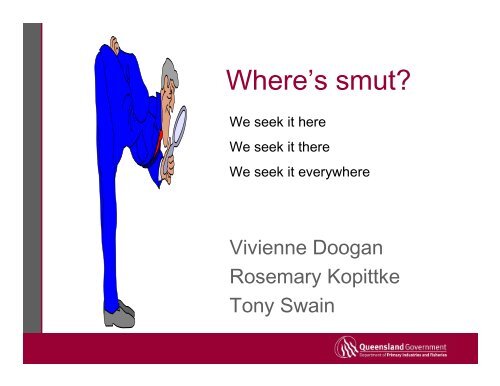Where's smut?
Where's smut?
Where's smut?
- No tags were found...
Create successful ePaper yourself
Turn your PDF publications into a flip-book with our unique Google optimized e-Paper software.
Where’s <strong>smut</strong>?We seek it hereWe seek it thereWe seek it everywhereVivienne DooganRosemary KopittkeTony Swain
Typical <strong>smut</strong> whip and thin grassy shoot
Simulations• Done in GenStat• Range of imposed infectionpatterns• Range of inspectionmethods• Successful run defined asdetecting the disease
Patterns of infection
Methods of inspection
Parameters• Block size: 100 rows with 1,150 plants perrow (115,000 plants)• Confidence level: 99%• Sensitivity: 100%• Number of runs: 5,000 for each simulation• Sample size / prevalences: We couldn’tarbitrarily select prevalences to examinesince we had restrictions on the sample sizesdetermined by the length of a row for 4 of the6 sampling methods, so …
• we chose samples ranging between 2,300 plants (1double row) and 13,800 plants (6 double rows)• then, determined prevalences which should be detectedby sampling the above; roughly between 0.002 and0.000335 depending on the method used
Imposed infection levelsInfectionlevelPlantssampledDouble rowssampledPlantsinfected0.00198230012280.000983460021130.00064369503740.00047892504550.000383114255440.00031313800636
Estimating sample numbers /prevalences• Cannon and Roe:Preliminary runs (randominfection only)• Modified hypergeometricexact: (used FreeCalc v 2.0)a full series of runs for thedifferent infection patternsand inspection methods
Random infectionPreliminary – Cannon and Roe100.0Percent successful runs99.599.098.50 0.0002 0.0004 0.0006 0.0008 0.001 0.0012 0.0014 0.0016 0.0018 0.002Infection levelRDR SDR RP SP
• Distinct upwardtrend in percentsuccessful runs• Overkill• Assumption thatpopulation can beconsidered infiniteat 10,000 is leadingto oversampling
Random infection - modified hypergeometric exact100Percent successful runs99.59998.50 0.0002 0.0004 0.0006 0.0008 0.001 0.0012 0.0014 0.0016 0.0018 0.002Infection levelRDR SDR RSR SSR RP SP
Cl uster salong a rowDouble row sampling100Pl ant based sa mpl i ng90Cl ust er of 2Percent successful runs80706050Cl ust er of 3Cl ust er of 5DR sa mpli ng40Cl ust er of 12300 0.0005 0.001 0.0015 0.002 0.0025Infection levelRDR Cluster 5 SDR Cluster 5 RP Cluster 5 SP Cluster 5 RDR Cluster 12 SDR Cluster 12 RP Cluster 12 SP Cluster 12RDR Cluster 3 SDR Cluster 3 RP Cluster 3 SP Cluster 3 RDR Cluster 2 SDR Cluster 2 RP Cluster 2 SP Cluster 2
Cluster of 12 plants along a row• No realdifferencesevident betweendouble and singlerow sampling• Both dramaticallyworse than plantbased samplingPercent successful runs10090807060504030200 0.0002 0.0004 0.0006 0.0008 0.001 0.0012 0.0014 0.0016 0.0018 0.002Infection levelRDR SDR RP SP RSR SSR
Rectan gular cl usterin g3*4 in two configurations4/row * 3 rows3/row * 4 rows1001009090Percent successful runs8070Percent successful runs80706060500 0.0002 0.0004 0.0006 0.0008 0.001 0.0012 0.0014 0.0016 0.0018 0.002500 0.0002 0.0004 0.0006 0.0008 0.001 0.0012 0.0014 0.0016 0.0018 0.002Infection levelInfection levelRDR SDR RP SP RSR SSRRDR SDR RP SP RSR SSR
Rectan gular cl usterin g6*2 in two configurations6/row * 2 rows1002/row * 6 rows1009090Percent successful runs807060Percent successful runs8070605050400 0.0002 0.0004 0.0006 0.0008 0.001 0.0012 0.0014 0.0016 0.0018 0.002Infection level400 0.0002 0.0004 0.0006 0.0008 0.001 0.0012 0.0014 0.0016 0.0018 0.002Infection levelRDR SDR RP SP RSR SSRRDR SDR RP SP RSR SSR
Systematic selection“for pests with a clustering distribution, asystematic survey can provide a betterchance of detecting the pest than a randomsample”;a random sample “may be ineffective indetecting the pest, particularly at low pestlevels”Guidelines for the establishment of pest freeareas for Australian quarantine (Jorgensen,Cannon and Muirhead 2003) pg 72
Rectan gular cl usterin g(2/row * 6 rows)100Percent successful runs9080700 0.0002 0.0004 0.0006 0.0008 0.001 0.0012 0.0014 0.0016 0.0018 0.002Infection levelRDR SDR RP SP RSR SSR
Random or systematic?• Random plants based sampling alwaysachieved the target level• Systematic plant based samplingsometimes achieved higher than thetarget though could achievedramatically lower levels of confidence• Problems when step size is exactlydivisible into row length
Estimating prevalenceClustering – 3 plants along a row• Over the 5,000 simulation runs– means same for all sampling strategies– at lowest prevalence tested (0.000313) all methods producedacceptable estimates (0.0003125 to 0.0003181)• Range in any single run– double row sampling gives a wide range – distribution skewed tothe left• between 0 and 18 detections in a run for random DR• between 0 and 21 detections in a run for systematic DR– Single row sampling also gives a wide range – distribution skewedto left• Between 0 and 21 detections in a run for random SR• Between 0 and 18 detections in a run for systematic SR– plant based sampling has a narrower range – normal distribution ofresults• between 0 and 13 for random selection of plants• between 0 and 10 for systematic selection of plants
Systematic by double rowSystematic by plant
Clustering – 12 plants – 6/row * 2 rows• Over the 5,000 simulation runs– means same for all sampling strategies– at lowest prevalence tested (0.000313) all methods producedacceptable estimates (0.0003134 to 0.0003205)• Range in any single run– double row sampling gives a wide range – distribution skewed tothe left• between 0 and 36 detections in a run for random DR• between 0 and 36 detections in a run for systematic DR– Single row sampling also gives a wide range – distribution skewedto left• Between 0 and 24 detections in a run for random SR• Between 0 and 18 detections in a run for systematic SR– plant based sampling has a narrower range – normal distribution ofresults• between 0 and 13 for random selection of plants• between 0 and 6 for systematic selection of plants
Conclusions & practical implications• If the infection is clustered then plant basedsampling is required to attain the confidencethe sample numbers suggest• If systematic sampling is employed then careneeds to be taken to ensure that the step sizechosen is not divisible into the number ofplants in a row thus producing a grid whicheffectively misses strips• All sampling methods unbiased for estimatingprevalence but estimates from row basedsampling are more variable
















